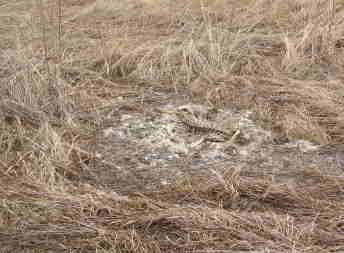![]() Observation: The First Step in the Scientific Method
Observation: The First Step in the Scientific Method
To observe means to look at something. Good observers notice the details. When scientists observe things, they ask questions. Scientists then seek to answer their questions. These observations are the initial step in the scientific method.
Observations are also called data. There are two kinds of data.
- Qualitative data are descriptions that do not have numbers.
Example: Bill told his grandfather he saw a huge Ursus americanus eating sunflower seeds from his mother's backyard bird feeder.
- Quantitative data are obtained by measuring and have numbers. Scientists use a variety of specialized instruments (tools) to obtain numbers based data.
The wildlife officer reported that the 4,164 black bear harvest was the largest in state history. He said the ages of the bears ranged from 10 months to 26 years 10 months. Seventy percent (70% ) of them were 5 years 10 months old or younger. The largest bear weighed 228kg. The estimated statewide population of black bears remains stable at 14,000. This report is an example quantitative data.
Practice making observations:
In late winter, Amy was walking home from school. She saw this in a field, along the road.
Click on the photo for a closer view. Use the Back Button of your browser to return to this web page.
1. Write your observations. Include qualitative and quantitative data.
2. Fire up your imagination or curiosity. Write at least two questions about what Amy observed in the field.
3. Based on your observations: What do you think this is?
Explain your thinking.
4. Predict: What will eventually happen to this stuff?
Resources:
About Units of Measurement - IB Biology | Observing Biology how to's
Steps of the Scientific Method - Science Buddies | Decomposition
Observation Skills Builders index | The Scientific Process | Learn about the Scientific Method Activity
"If future generations are to remember us with gratitude rather than contempt, we must leave them more than the miracles of technology. We must leave them a glimpse of the world as it was in the beginning, not just after we got through with it." President Lyndon B. Johnson
Water Study Unit | Bluebirds Project | Fields, Meadows & Fencerows EcoStudy Unit | Teen Health Project
![]()
All trademarks, copyright and logos belong to their respective owners.
Internet Hunts / Nature / Plants & People / Computers / Famous Pennsylvanians / Civics & History / Puzzles & Projects / Site map / Home
Posted
by Cynthia J. O'Hora 3/2009, released for noncommercial use by nonprofit organizations
Aligned
with Pennsylvania Academic Standards | Assessment and Rubrics
![]() Save a tree - use a Digital Answer Format - Highlight the text. Copy it. Paste it in a word processing document. Save the document in your folder. Answer on the word processing document in an easily read, contrasting color or font. (Not yellow ) Avoid fancy fonts like Symbols, Techno,
Save a tree - use a Digital Answer Format - Highlight the text. Copy it. Paste it in a word processing document. Save the document in your folder. Answer on the word processing document in an easily read, contrasting color or font. (Not yellow ) Avoid fancy fonts like Symbols, Techno, ![]() fonts). Save frequently as you work. I have never liked losing my work. You will not like it either. Be sure to enter your name & the date at the top of the document. Submit via email attachment or class dropbox. Bad things happen: Save a copy of the response document for your records.
fonts). Save frequently as you work. I have never liked losing my work. You will not like it either. Be sure to enter your name & the date at the top of the document. Submit via email attachment or class dropbox. Bad things happen: Save a copy of the response document for your records.
Proof your responses. It is funny how speling errors and typeos sneak in to the bets work. ![]() Make your own printer paper answer sheet
Make your own printer paper answer sheet
Pennsylvania Academic Standards - The Nature of Science
Processes, Procedures and Tools of Scientific Investigations
• Apply knowledge of scientific investigation or technological design in different contexts to make inferences to solve problems.
• Use evidence, observations, or a variety of scales (e.g., time, mass, distance, volume, temperature) to describe relationships.
National Science Education Standards:
CONTENT STANDARD G: As a result of activities in grades 9-12, all students should develop understanding of:
NATURE OF SCIENTIFIC KNOWLEDGE
Scientific explanations must meet certain criteria. First and foremost, they must be consistent with experimental and observational evidence about nature, and must make accurate predictions, when appropriate, about systems being studied. They should also be logical, respect the rules of evidence, be open to criticism, report methods and procedures, and make knowledge public. Explanations on how the natural world changes based on myths, personal beliefs, religious values, mystical inspiration, superstition, or authority may be personally useful and socially relevant, but they are not scientific.
Because all scientific ideas depend on experimental and observational confirmation, all scientific knowledge is, in principle, subject to change as new evidence becomes available. The core ideas of science such as the conservation of energy or the laws of motion have been subjected to a wide variety of confirmations and are therefore unlikely to change in the areas in which they have been tested. In areas where data or understanding are incomplete, such as the details of human evolution or questions surrounding global warming, new data may well lead to changes in current ideas or resolve current conflicts. In situations where information is still fragmentary, it is normal for scientific ideas to be incomplete, but this is also where the opportunity for making advances may be greatest.
